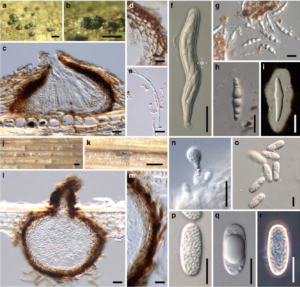Aquasubmersa japonica A. Hashim. & Kaz. Tanaka, sp. nov.
Index Fungorum number: IF551422; Facesoffungi number: FoF00956; Fig. 1
Etymology – named after the country of origin, Japan.
Holotype – HHUF 30469
Saprobic on dead wood. Sexual morph: Ascomata 180 – 210(− 300) μm high, 115 – 175(− 230) μm diam., scattered to grouped, subglobose, immersed to semi-immersed. Ostiole 10 – 16 μm high, short papillate, lacking a clypeus. Peridium 20 – 30 μm wide, composed of 4 – 7 layers of flattened, 8 – 12.5 × 2.5 – 5.5 μm, thin – walled cells of textura angularis, black at the outside. Hamathecium comprising numerous, 2 – 4.5 μm wide, hyaline, septate, branched pseudoparaphyses. Asci (60–) 66 – 93 × (4.5–) 5.5 – 8 μm (x̄ = 76 × 6.2 μm, n = 17), 8 – spored, bitunicate, cylindrical, with a short pedicel (9 –14 μm long), apically rounded, with an ocular chamber. Ascospores 20 – 26 × 4 – 5.5(− 6) μm (x̄ = 23.2 × 4.6 μm, n = 65), L/W (3.7–) 4 – 6 (−6.5) (x̄ = 5.1, n = 65), biseriate, hyaline, broadly fusiform with rounded ends, straight, with a mostly median septum (0.45 – 0.54; x̄ = 0.50, n = 65), smooth, guttulate when young, with an entire sheath; sheath when fresh condition diffuse, gelatinous, up to 10 μm wide, later becoming sharply delimited firm sheath of 1.5 – 4 μm thick. Asexual morph: Coelomycetous. Conidiomata pycnidial, globose to subglobose, up to 215 μm high in section, 115 – 195 μm diam., scattered, semi-immersed, solitary, black to brown. Ostiole 53 – 80 μm high, short papillate, circular, dark – brown, central. Peridium 20 – 25 μm wide, composed of 9.5 – 12.5 × 3 – 7.5 μm, polygonal, hyaline to brown cells; Conidiophores reduced. Conidiogenous cells holoblastic, 9 – 12 × 5.5 – 6.5 μm, lageniform, hyaline, smooth. Conidia ellipsoidal, 17 – 22 (−23) × (7–) 8 – 9 μm (x̄ = 19.4 × 8.4 μm, n = 50), L/W 1.9 – 2.7 (x̄ = 2.3, n = 50), hyaline, smooth, guttulate when young.
Culture characteristics – Ascospores formed in culture are similar to those on natural substrate.
Material examined – JAPAN, Okinawa, Isl. Ishigaki, Banna Park, on dead wood, 16 July 2011, K. Tanaka & K. Hirayama KT 2862 (HHUF 30469, holotype), ex-type living culture, MAFF 245219; ibid. KT 2863 (HHUF 30470, paratype), living culture, MAFF 245220. JAPAN, Okinawa, Isl., Iriomote, Oomija River, on submerged wood, 12 July 2011, K. Tanaka & K.Hirayama KT 2813(HHUF 30468, paratype), living culture, MAFF 245218.
Notes – The asexual characters of A. japonica show a good match with the generic concepts of Aquasubmersa. The conidia of A. japonica differ in being slightly larger than those of A. mircensis (18.3 × 9.4 μm; Zhang et al. 2012b). ITS sequence differences between our materials of A. japonica and the ex-type strain of A. mircensis (NR 121545) were found at 27 – 28 positions with three gaps.

Fig. 1 Aquasubmersa japonica a, b Appearance of ascomata on substrate c Ascoma in longitudinal section d Peridium. e Pseudoparaphyses f Ascus g, h Ascospores with mucilaginous sheath i Ascospore in India ink j, k Conidiomata in culture l Conidioma in longitudinal section m Peridium of conidioma n Conidiogenous cell and immature conidium o – r Conidia. a, b, e, h, i from HHUF 30469; c, d, g from HHUF 30470; f from HHUF 30468; j – r from culture MAFF 245220. Scale bars: a, b = 200 μm, c, f, l = 20 μm, d, e, g – i, m – r = 10 μm, j, k = 300 μm.
